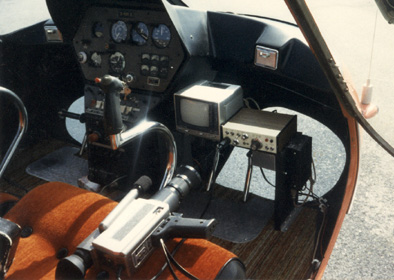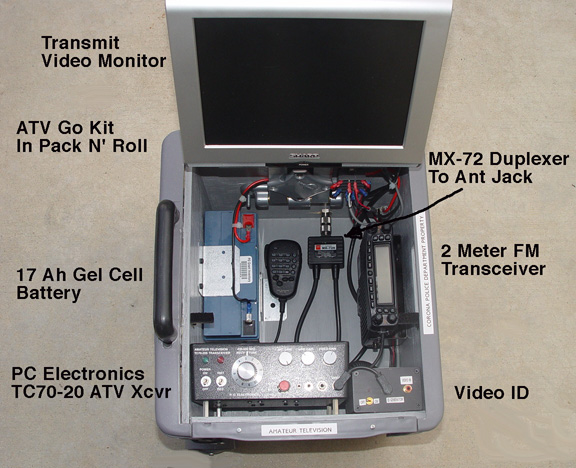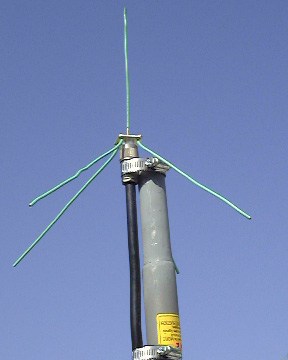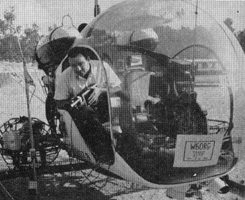 Later, in 1988, I installed 434 MHz ATV in my Enstrom F28C helicopter to demonstrate the feasibility of transmitting earthquake damage sites back to the Los Angeles County Emergency Operations Center. Today the LA County Sheriffs RACES can operate ATV in 4 helicopters and many mobile ground units including one portable repeater. There are also over two dozen city and county emergency service ham organizations in Southern California that use mobile and airborne ATV as part of their emergency communication operations. In 1989 I got to fly my ATV Telecopter in support of the Pasadena Rose Parade. See the video.
Later, in 1988, I installed 434 MHz ATV in my Enstrom F28C helicopter to demonstrate the feasibility of transmitting earthquake damage sites back to the Los Angeles County Emergency Operations Center. Today the LA County Sheriffs RACES can operate ATV in 4 helicopters and many mobile ground units including one portable repeater. There are also over two dozen city and county emergency service ham organizations in Southern California that use mobile and airborne ATV as part of their emergency communication operations. In 1989 I got to fly my ATV Telecopter in support of the Pasadena Rose Parade. See the video.
For my initial helicopter flights, the video was noisy and quite a puzzle since the noise did not occur on the ground even with the engine and rotor turning. Finally I realized that the braid of the RG58 coax to the antenna would vibrate enough to change contact resistance between the strands and that would show up as an AM modulation from SWR change. The solution is to use Teflon double shielded coax with tight braid or aluminum foil. I suggest RG400, which you can possibly get from companies that do mobile cellular phone installations, or RG162.
 Antenna type and placement is another unique problem. What works best is a stiff quarter-wave spike on the belly. Quarter wave ground planes have about a 15 degree main lobe up-tilt in the radiation pattern and soft nulls on up. Placing the antenna on the belly places most of the power toward the ground rather than outer space if mounted on top of the aircraft. Longer gain antennas have narrower vertical pattern lobes which can cause signal drop out nulls sooner as the aircraft increases its banking turns. A vertical omni is the simplest and will give the best over all coverage in flight. Many are commercially available. A horizontal omni is very difficult to mount since it must be placed away from the aircraft metal skin so as not to affect its pattern and it will have much more wind resistance. A temporary inverted quarterwave whip can be clamped to the skid support as shown.
Antenna type and placement is another unique problem. What works best is a stiff quarter-wave spike on the belly. Quarter wave ground planes have about a 15 degree main lobe up-tilt in the radiation pattern and soft nulls on up. Placing the antenna on the belly places most of the power toward the ground rather than outer space if mounted on top of the aircraft. Longer gain antennas have narrower vertical pattern lobes which can cause signal drop out nulls sooner as the aircraft increases its banking turns. A vertical omni is the simplest and will give the best over all coverage in flight. Many are commercially available. A horizontal omni is very difficult to mount since it must be placed away from the aircraft metal skin so as not to affect its pattern and it will have much more wind resistance. A temporary inverted quarterwave whip can be clamped to the skid support as shown.
The landing gear on fixed wing or the skids on helicopters can also put significant nulls in the antenna pattern. It usually works out best to place the inverted quarterwave ground plane antenna back on the tail cone as far as possible to minimize the effects of the landing gear. You will probably find best radiation to the sides and rear of the aircraft and worst straight ahead. Before flying an actual demonstration or event it is best to find out where your radiation peaks and nulls are by having a ground station describe the signal strength changes to you on two meters as you make flat 360 degree turns. That way when you are shooting a significant scene you can fly your position relative to the receiving station, as well as sun angle, for the best video at the receive site.
For the antenna, I used 1/8" diameter solid brass rod about 6.5" long and then trimmed for minimum reflected power. However you will have to find a ham friendly FAA certified radio shop to install your antenna or sign off your work to be legal. They may be resistant to installing antennas that are not made for aircraft. There is, however, a company who does make FAA certified antennas for the ham bands - Comant, (562) 946-6694. They have both 2 meter and 440 MHz antennas. I have not tried it but I would think that one of their 2 meter quarter-wave antennas would also work as a 3/4 wave on 70cm ATV. If it does, then you can use just the one antenna and coax for both bands using a Diamond MX72N duplexer.

The FAA says that anything that is fastened to the aircraft must be approved and signed off. To get around this, the ham equipment can all be put in a plastic milk crate, Pack N' Roll or opened suitcase and strapped into one of the seats - see May 2006 page 28 QST article by AC6Y on building an ATV Go kit for the Corona CA PD helicopters and also our Milk Crate ATV Repeater app note. This way it can be easily placed in any aircraft, as long as it has the antenna installed, put in other vehicles or taken portable. A gel-cell can be used to power the equipment or a cigarette lighter plug into the vehicles power if available.
First, I suggest the TC70-20S ATV Transceiver (check eBay for used units) as the higherst power for aircraft use. 20 watts is generally not too high to bother the avionics gear as long as there is some antenna separation - this should be checked out on the ground before taking off. You can also use the 5 Watt TX70-5s or package a Videolynx VM-70X.
Second, the 5 amps of current is not too high to draw down a 17 Ah gel-cell all the way on a typical flight or be of any real concern to the aircraft's total currant draw or wiring. Also the amount of heat dissipation does not require a fan or will adversely raise the cockpit temperature. If the aircraft power is 28 volts a series regulator on a heat sink is still not so big as would be required if a higher power amplifier was added.
 Third, the line of sight snow free picture dx with 20 watts p.e.p. on the 70cm band is about 33 miles given the quarter wave spike and a 9 dBd Diamond F718 vertical omni on the ground or over 10 miles with ground planes on each end. 5 Watts would be half those distances. For local city emergency communications with helicopter ATV, you might do better with a ground plane to receive given its 15 degree uptilt. A gain omni will have nulls in the pattern close in since their gain is concentrated on the horizon rather than above. You can get farther if you have line of sight and a higher gain beam that can track the aircraft in both azmuth and elevation, or you don't mind a little snow. At 5000 feet above ground level, the RF horizon over flat terrain is 100 miles. Your 20 watts on 70cm will give a P3 to P4 picture (P5 being snow free - see ARRL Handbook ATV section) to an ATV station with a 14 dBd beam. See ATV DX Variables. If the aircraft is not line of sight, the scene can be taped with a camcorder and then the aircraft can climb up to line of sight to play the tape.
Third, the line of sight snow free picture dx with 20 watts p.e.p. on the 70cm band is about 33 miles given the quarter wave spike and a 9 dBd Diamond F718 vertical omni on the ground or over 10 miles with ground planes on each end. 5 Watts would be half those distances. For local city emergency communications with helicopter ATV, you might do better with a ground plane to receive given its 15 degree uptilt. A gain omni will have nulls in the pattern close in since their gain is concentrated on the horizon rather than above. You can get farther if you have line of sight and a higher gain beam that can track the aircraft in both azmuth and elevation, or you don't mind a little snow. At 5000 feet above ground level, the RF horizon over flat terrain is 100 miles. Your 20 watts on 70cm will give a P3 to P4 picture (P5 being snow free - see ARRL Handbook ATV section) to an ATV station with a 14 dBd beam. See ATV DX Variables. If the aircraft is not line of sight, the scene can be taped with a camcorder and then the aircraft can climb up to line of sight to play the tape.
Note that the lower the frequency, the farther the distance given the same power and antenna gains due to antenna area. Therefore, the 420-450 MHz band is suggested rather than 902-928 MHz, which would give half the distance, or 1240-1300 MHz at 1/3. However you could make up some of the difference on the higher bands with higher gain beams. Every 6 dB increase doubles the distance for the same signal level, or improves the picture one P unit at the same location. The other bonus of using the 70cm band is that the ATV can also be picked up on a cable ready TV tuned to cable channels 57 through 60 with just a good outside 70cm antenna. This makes it easy to have additional TV reception at other emergency service sites with little expense or effort.
It is best to check with local ATVers to find out the coordinated ATV frequencies so that you do not interfere with other band users or unknowingly key up a local ATV repeater. Using the local two meter ATV coordination channel while airborne helps with minimizing interference, getting signal reports and sparking interest. With only two ATV channels in the 70cm band available in any given area, and emergency operations sometimes taking quite a while, coordinating on two meters can go a long way in keeping other users patient.
Don't forget to identify every 10 minutes and at the end of a transmission by voice on the sound subcarrier or call letters on the video. You can make a card up with fat black printing of your call and the two meter frequency you are coordinating on. Intuitive Circuits makes and we stock a video overlay board which will put your call ID info on the screen for 5-10 seconds every 9 minutes to automatically satisfy the FCC Rule 97.119 legal requirement. We also stock their board that will overlay location and other information directly from a GPS receiver along with the station ID.
Fourth, you many think you only need a transmitter in the aircraft. But a receiver is a big help to see if anyone else is on that you might interfere with before you transmit from your big antenna in the sky. Seeing the other ATV stations during an emergency operation will keep you from transmitting over them as well as giving you a better feel for what is going on. Which ATV station is transmitting is usually coordinated on two meters but seeing the station actually turn off before you turn on looks much better especially to the non-hams on the ground watching. The Rose Parade ATV had as many as 17 stations to coordinate.
The little liquid crystal TV receivers are perfect for portable use. Some TV's even have a video input which can be plugged into the transceivers monitor output so you can see your own camera video for fine video gain adjustment rather than rely on comments from the ground. The TV / monitor also makes it easier to see what you are shooting versus the eye piece types of camcorders. You may have to make and tape a cardboard hood around the screen to block direct sunlight from obscuring the image.
Only cameras with solid state pick up devices should be used. The old vidicon cameras will get streaks or burns that can be permanent if accidentally pointed at the sun. CCD or MOS cameras or camcorders work the best. A camcorder will allow taping at the same time or playing back at a later date. See our web page for cameras. Hand holding the camera will dampen out the aircraft vibration rather than affixing it to a tripod or aircraft structure. Start with wide angle shots and practice tracking the scene on the ground in the monitor with slow steady hand movement. As you get the hang of it, you can try the zoom, because you don't want those on the ground to get air sick watching your video.
Hearing the two meter FM voice coordination channel versus the aircraft communications in the cockpit can be a problem, especially if headsets are normally used such as in helicopters. Your aircraft radio shop can set you up with a pair of jacks for an external radio to select from your aircraft audio panel but the cost and complexity may be more than you want to do. I use an earpiece under the headset plugged into my HT or transceiver. That way the pilot does not have to listen to the ham chatter or juggle the relative volumes, but the camera operator can hear both the aircraft communications and or intercom as well as coordinate with the hams on the ground via the two meter transceiver. An ear piece can also be plugged into the TV to hear the ATV audio as well.
Noise canceling or Low impedance dynamic directional mics work best for ATV in high noise environments. Do not use the omni mic that is part of the camcorder; you will pick up too much noise. It is tempting to close talk and shout into the mic so make sure you have turned the mic gain down low enough that your voice does not come out all distorted. The mic audio controls are on the front of the ATV transceiver but you will have to go inside most two meter transceivers to make the adjustment.
Airborne ATV can be a lot of fun as well as serving as a valuable eye in the sky for emergency service commanders. Transmissions must be controlled by a licensed amateur and transmitted to at least one other amateur who is receiving the transmission - no one way transmissions or broadcasting per 47 CFR 97.111 and 97.113. One word of caution however, Amateur radio frequencies cannot be used for normal police, fire, CAP or government use except for RACES drills for emergency preparedness - see the details. FCC Rule 97.407 limits operation to one hour per week, no more than two 72 hour drills per year and must be approved by the areas RACES authorities. It is tempting for some of these agencies to want to use ATV as an inexpensive tool for their normal business rather than their own microwave frequencies and type accepted equipment after they have observed what hams can do at public service events and for ARES communications drills.
See you in the air, Tom O'Hara, W6ORG
Go to:












 I first put ATV in a Los Angeles County Sheriff's helicopter for the Pasadena, CA Police to enable them to get a birds eye view of the chaotic traffic flow from the New Year's Day Rose Parade to the Rose Bowl in 1968 (QST May 1968 page 106). The cars leaving the beginning of the parade route would all clog the few streets that lead down into the Rose Bowl two miles away causing grid lock. As a result of being able to see the big picture (pun intended) and better direct traffic, Pasadena PD bought their own helicopters the following year and our ham group was out of that facet of Rose Parade communications. The set up was quite a kludge with an ATV converted tube type RCA CMU-10 FM voice transceiver, DC/AC inverter, power supply and antenna all strapped down in a victims basket of a Bell H47.
I first put ATV in a Los Angeles County Sheriff's helicopter for the Pasadena, CA Police to enable them to get a birds eye view of the chaotic traffic flow from the New Year's Day Rose Parade to the Rose Bowl in 1968 (QST May 1968 page 106). The cars leaving the beginning of the parade route would all clog the few streets that lead down into the Rose Bowl two miles away causing grid lock. As a result of being able to see the big picture (pun intended) and better direct traffic, Pasadena PD bought their own helicopters the following year and our ham group was out of that facet of Rose Parade communications. The set up was quite a kludge with an ATV converted tube type RCA CMU-10 FM voice transceiver, DC/AC inverter, power supply and antenna all strapped down in a victims basket of a Bell H47.
 Antenna type and placement is another unique problem. What works best is a stiff quarter-wave spike on the belly. Quarter wave
Antenna type and placement is another unique problem. What works best is a stiff quarter-wave spike on the belly. Quarter wave 
 Third, the line of sight snow free picture dx with 20 watts p.e.p. on the 70cm band is about 33 miles given the quarter wave spike and a 9 dBd Diamond F718 vertical omni on the ground or over 10 miles with
Third, the line of sight snow free picture dx with 20 watts p.e.p. on the 70cm band is about 33 miles given the quarter wave spike and a 9 dBd Diamond F718 vertical omni on the ground or over 10 miles with 
